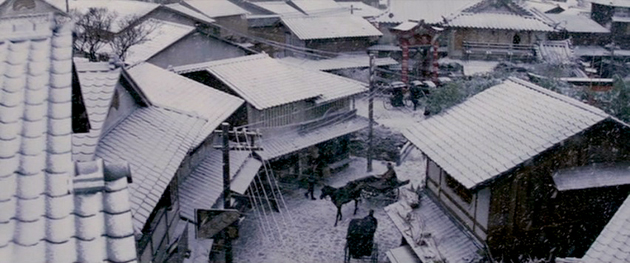John Myhre

We really specifically wanted to get into really narrow corridors and narrow streets and crooked little passageways and we wanted to be able to see the eaves of the buildings and shops so Dion really, really used the model to help plan shots. And it was fantastic because the model was in the art department but every day there was some department in looking at it- Special FX, figuring out where they could be to lay snow in, Dion and visual effects figuring out shots. It was really, really well-used. We did have to laugh because even though it was just a quarter-inch model and even though it was with a little video lipstick camera it was astonishing how accurate it was, in a funny way.
I think there’s even a DVD that shows Dion moving the video camera in for a big shot he was planning with a crane which then dissolves into the actual shot he used in the film. Time and time again it just felt like we had already been there. You saw the colors, you saw the buildings, you saw the angles of the street, and you saw the characters in the street, the rickshaws. You knew where the river went and how high the bridges were. And Dion and Rob and I used that model for two months while the town was being built. And when they all showed up at the town, they were familiar with it. They knew they’d walk and there’d be a tea-shop here and a fish store here and a little alleyway here, and Oh, that’s the big tree. Look at the great shot from the big tree if you just turn around the corner. And it was all there. It was invaluable and it was really fun.
AS: In Nine did I hear that you had a fully-built, alternate set that the dancers would work on?
JM: Rob Marshall is the choreographer as well as the director on all these musicals. Rob and John DeLuca acted as choreographers. And Rob comes from a Broadway background which is very precise, so I’ve just been trained up by the very best people to do musicals. And he creates the dance and the musical numbers. My favorite thing in the world in movies is to work on musicals because it’s pure film and pure design and pure creation.
Normally as a production designer the first thing you do is set up an art department with drawing tables and get in illustrators and computers. The first thing you do with Rob Marshall is set up a dance hall. So you bring in a sprung dance floor, you bring in a hundred-foot wall of mirrors, you start bringing in rehearsal props. I get to be really involved with the creation of the dance working with Rob. He’s constantly calling me down and saying, Well, the proscenium opening that we thought would be thirty feet is actually going to need to be a little wider and I’ll show you why, and he’ll have one of the dancers dance. And I’ll pull out my tape measure and he says, That doesn’t fit into thirty feet does it? And I go, No. He says, Okay, how small can we make it? So it needs to be thirty-five feet, okay.
I get to work with him on the artistic creation of the visual look of the dance and then I get to respond to physically how the dance has been choreographed and laid out. And he will lock in a dance number two months before we shoot it and he’ll count on me that everything is not to the inch but to the quarter-inch. Because the dancers he works with are so trained that if they are doing three flips and land on a chair they could do it blind-folded. But that chair better be exactly seventeen inches tall and the top of the chair better be exactly the size it was and the chair needs to be exactly where it was on that dancehall. Sometimes you’re dealing with three-hundred items that have to be locked in and marked that carefully. On Chicago we made it all work on a stage that we had the flexibility of making deeper if we wanted to, or wider if we wanted to, so Rob was really free to create anything he wanted in terms of the dance and we’d respond to it.
Pingback: David Warren
Pingback: Jess Gonchor
Pingback: David Wasco & Sandy Reynolds-Wasco